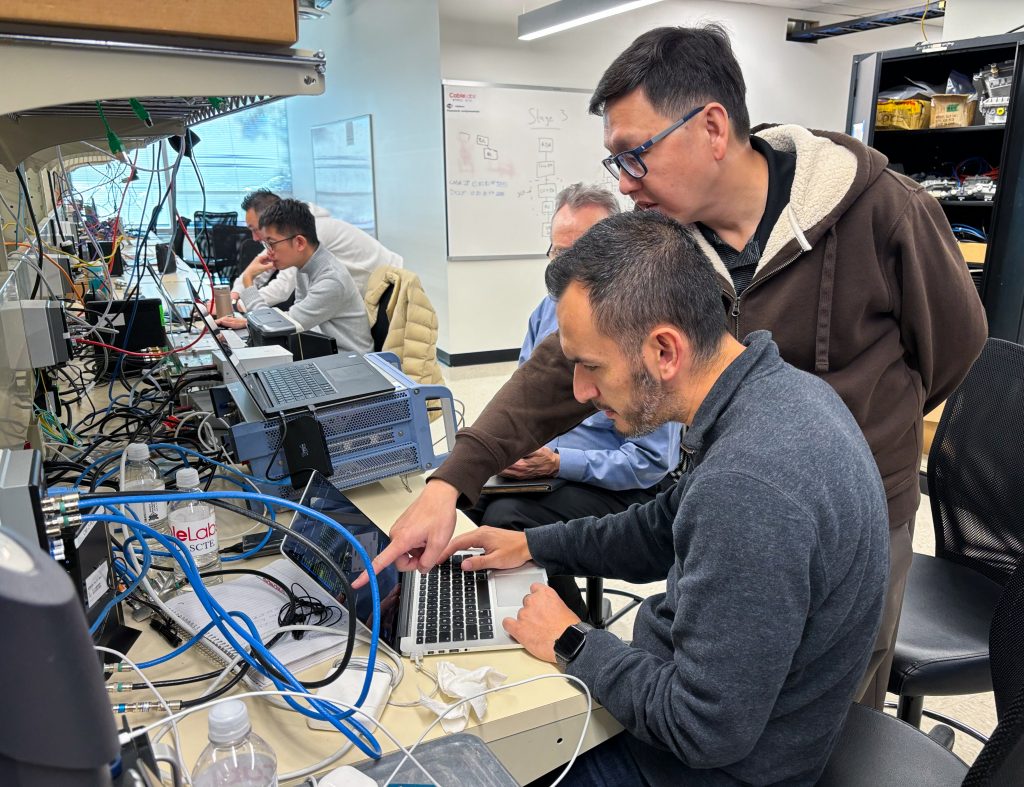DOCSIS
Focus Shifts to Network Reliability in DOCSIS 4.0 Interop·Labs Event
CableLabs and Kyrio hosted a DOCSIS® 4.0 Interop·Labs event November 6–9 at our headquarters in Louisville, Colorado. It was a busy, week-long experience that highlighted multiple facets of DOCSIS 4.0 technology, and the many suppliers involved worked together to make it a success.
The primary focus of the event was network reliability — in particular, DOCSIS 4.0 cable modem (CM) proactive network maintenance (PNM) functions in DOCSIS 4.0 cable modem termination systems (CMTSs). There also were Remote PHY Device (RPD) interoperability exercises.
At this interop, four DOCSIS 4.0 CMs from four suppliers were interconnected to both DOCSIS 4.0 and DOCSIS 3.1 CMTSs from three companies. Participating suppliers were Arcadyan, Casa Systems, DCT-DELTA, Harmonic, Sagemcom, Ubee Interactive, and Vecima Networks. Rohde & Schwarz also participated with its DOCSIS 4.0 test system. Operators attended to observe the interop and talk about their DOCSIS 4.0 technology plans.

Engineers collaborate in a DOCSIS 4.0 Interop·Labs event at CableLabs' headquarters in November.
Network Reliability at the Forefront
Every day, hundreds of millions of broadband consumers use DOCSIS technology, and they depend on a reliable connection. DOCSIS PNM, which uses data provided by DOCSIS equipment, is foundational to the reliability of that connection.
For operators to keep tabs on the network and their offered services, data elements need to be both available and accurate. The goal of PNM is to fix issues before customers even realize there is a problem — before any service impacts occur.
PNM technology can be summarized into three areas: data collection, algorithms that use the data to analyze the network, and network operations to ensure continuous service.
Data collection. DOCSIS equipment generates vast amounts of network performance data to detect and measure issues within the cable plant. What kind of data? Data about both downstream and upstream RF performance, data on the spectrum in use, data on the signals on the coaxial cable, data on how the transmitters and receivers are operating, and more. At the interop event, we verified that the data reporting is both there and correctly formatted. For operator systems to use that data effectively, it has to be standardized in order for every modem from every manufacturer to report apples-to-apples information so that operator systems can use that data effectively.
Analysis algorithms. Once data is collected from the CMs, it’s run through algorithms to examine the health of the network. Systems sift through this data constantly, looking for anomalies. At the interop, the algorithms were discussed and compared, with operators describing how the data is used and what is being looked for.
Network operations. The DOCSIS PNM team maintains a reference document that describes how the data must be formatted, how it can be collected and which algorithms can be run on the data. Numerous SCTE Cable-Tec Expo papers discuss how to interpret the data and use it to maintain the network at the highest levels of service. The interop event featured eight high-runner PNM tests, collecting data from the DOCSIS equipment and putting it through algorithms. In the lab, it’s possible to simulate errored network conditions and use the data and algorithms to verify the condition of the network. SCTE is also involved with preparations for DOCSIS 4.0 tools and deployments, as Jason Rupe describes in the blog post “Ready, Set, 4.0: Tooling Up for DOCSIS Technology’s Rollout.”
A Comprehensive DOCSIS 4.0 Interop Event
Attending the event was one participant’s DOCSIS 4.0 virtual core platform and fiber node, which included a DOCSIS 4.0 extended spectrum DOCSIS (ESD) remote PHY device (RPD). This solution was a DOCSIS 4.0 ESD CMTS, and the DOCSIS 4.0 CM suppliers were excited to work with it. The DOCSIS 4.0 ESD CMTS operated both on a DOCSIS 4.0 ultra-high-split as well as up to 1.8 GHz on the coaxial cable. Both speed testing and security testing were examined against the DOCSIS 4.0 CMTS, continuing the work from previous interop events.
Remote-PHY Interop Exercises
DOCSIS 4.0 technology requires a distributed access architecture (DAA). At this interop, suppliers exhibited an array of DOCSIS 4.0 virtual cores. One supplier, which manufactures fiber nodes and RPDs, brought its DOCSIS 3.1 RPD with enhanced DOCSIS 3.1 capabilities. CableLabs and Kyrio were ready to support this kind of interop too. In essence, then, this wasn’t merely a DOCSIS 4.0 interop, but also a Remote PHY interop!
Collaborative DOCSIS Technology Evolution
At the DOCSIS 4.0 Interop·Labs event, CMTS and CM suppliers continued their efforts to verify that their equipment works together, further peeling the onion and diving into the nitty-gritty details of the specifications. This is where interoperability really happens.
All of the participants, along with us at CableLabs, left with a stronger understanding of product functionality and multi-vendor interoperability — and new work to do. Moving forward, the suppliers will continue to collaborate to refine their products and add further functionality.
Interop events are a major step toward large-scale deployment of DOCSIS 4.0 technology. Another step is certification. To find out more about Cable Modem Certification, click the button below.


